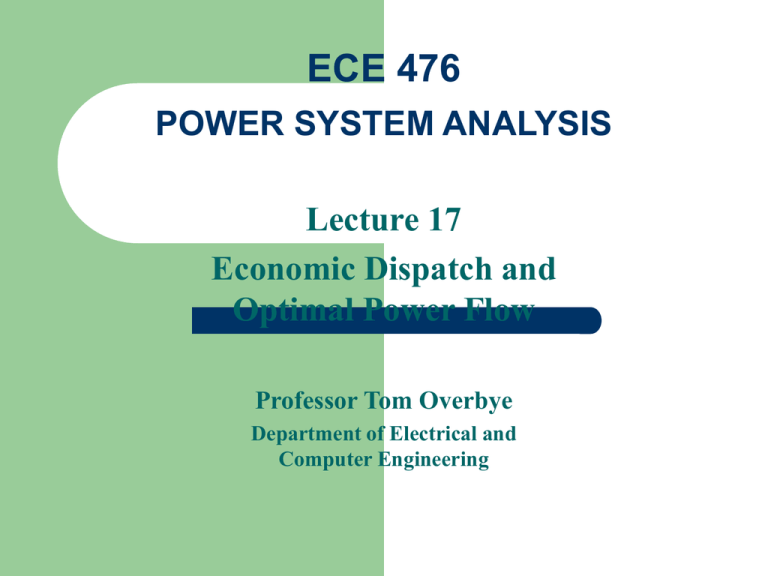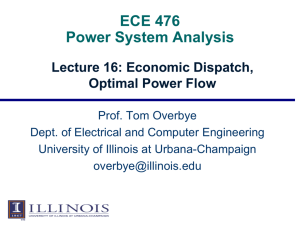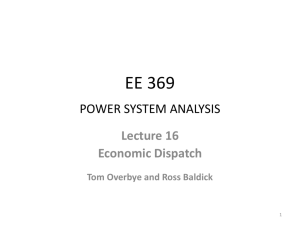Lambda-Iteration with Gen Limits
advertisement

ECE 476 POWER SYSTEM ANALYSIS Lecture 17 Economic Dispatch and Optimal Power Flow Professor Tom Overbye Department of Electrical and Computer Engineering Announcements Homework 8 is 11.19, 11.21, 11.26, 11.27, due on Thursday Homework 9 is 7.1, 7.17, 7.20, 7.24, 7.27 – you do not need to turn it in, but should do it before the exam Second exam is Tuesday Nov 13 in class Design Project 2 from the book (page 345 to 348) was due on Nov 15, but I have given you an extension to Nov 29. The Nov 29 date is firm! 1 Power System Economic Operation Power system loads are cyclical. Therefore the installed generation capacity is usually much greater than the current load. This allows options on how to meet the current load Generation costs can vary widely, with different technologies balancing – – – the capital costs necessary to build the generator the costs to actually produce electric power for example, nuclear and some hydro have high capital costs and low operating costs. Natural gas generators have low capital costs, and higher operating costs 2 Thermal versus Hydro Generation The two main types of generating units are thermal and hydro For hydro the fuel (water) is free but there may be many constraints on operation – – – fixed amounts of water available reservoir levels must be managed and coordinated downstream flow rates for fish and navigation Hydro optimization is typically longer term (many months or years) In 476 we will concentrate on thermal units, looking at short-term optimization 3 Generator types Traditionally utilities have had three broad groups of generators – – – baseload units: large coal/nuclear; always on at max. midload units: smaller coal that cycle on/off daily peaker units: combustion turbines used only for several hours during periods of high demand 4 Generator Cost Curves Generator costs are typically represented by up to four different curves – – – – input/output (I/O) curve fuel-cost curve heat-rate curve incremental cost curve For reference - 1 Btu (British thermal unit) = 1054 J 1 MBtu = 1x106 Btu 1 MBtu = 0.29 MWh 5 Heat-rate Curve Plots the average number of MBtu/hr of fuel input needed per MW of output. Heat-rate curve is the I/O curve scaled by MW Best for most efficient units are around 9.0 6 Incremental (Marginal) cost Curve Plots the incremental $/MWh as a function of MW. Found by differentiating the cost curve 7 Economic Dispatch: Formulation The goal of economic dispatch is to determine the generation dispatch that minimizes the instantaneous operating cost, subject to the constraint that total generation = total load + losses m Minimize CT Ci ( PGi ) i 1 Such that m PGi PD PLosses i=1 Initially we'll ignore generator limits and the losses 8 Unconstrained Minimization This is a minimization problem with a single inequality constraint For an unconstrained minimization a necessary (but not sufficient) condition for a minimum is the gradient of the function must be zero, f (x) 0 The gradient generalizes the first derivative for multi-variable problems: f (x) f (x) f (x) f (x) x , x , , x 1 2 n 9 Minimization with Equality Constraint When the minimization is constrained with an equality constraint we can solve the problem using the method of Lagrange Multipliers Key idea is to modify a constrained minimization problem to be an unconstrained problem That is, for the general problem minimize f (x) s.t. g(x) 0 We define the Lagrangian L(x,λ ) f (x) λ T g(x) Then a necessary condition for a minimum is the L x (x,λ ) 0 and L λ (x,λ ) 0 10 Economic Dispatch Lagrangian For the economic dispatch we have a minimization constrained with a single equality constraint L(PG , ) m m Ci ( PGi ) ( PD PGi ) i 1 (no losses) i 1 The necessary conditions for a minimum are L(PG , ) dCi ( PGi ) 0 (for i 1 to m) PGi dPGi m PD PGi 0 i 1 11 Minimization with Equality Constraint When the minimization is constrained with an equality constraint we can solve the problem using the method of Lagrange Multipliers Key idea is to modify a constrained minimization problem to be an unconstrained problem That is, for the general problem minimize f (x) s.t. g(x) 0 We define the Lagrangian L(x,λ ) f (x) λ T g(x) Then a necessary condition for a minimum is the L x (x,λ ) 0 and L λ (x,λ ) 0 12 Economic Dispatch Lagrangian For the economic dispatch we have a minimization constrained with a single equality constraint L(PG , ) m m Ci ( PGi ) ( PD PGi ) i 1 (no losses) i 1 The necessary conditions for a minimum are L(PG , ) dCi ( PGi ) 0 (for i 1 to m) PGi dPGi m PD PGi 0 i 1 13 Economic Dispatch Example What is economic dispatch for a two generator system PD PG1 PG 2 500 MW and C1 ( PG1 ) 1000 20 PG1 0.01PG21 $ / hr C2 ( PG 2 ) 400 15 PG 2 0.03PG22 $ / hr Using the Largrange multiplier method we know dC1 ( PG1 ) dPG1 20 0.02 PG1 0 dC2 ( PG 2 ) dPG 2 15 0.06 PG 2 0 500 PG1 PG 2 0 14 Economic Dispatch Example, cont’d We therefore need to solve three linear equations 20 0.02 PG1 0 15 0.06 PG 2 0 500 PG1 PG 2 0 0 1 PG1 20 0.02 0 0.06 1 PG 2 15 1 0 500 1 PG1 312.5 MW P 187.5 MW G2 26.2 $/MWh 15 Lambda-Iteration Solution Method The direct solution only works well if the incremental cost curves are linear and no generators are at their limits A more general method is known as the lambdaiteration – – the method requires that there be a unique mapping between a value of lambda and each generator’s MW output the method then starts with values of lambda below and above the optimal value, and then iteratively brackets the optimal value 16 Lambda-Iteration Algorithm Pick L and H such that m m L P ( Gi ) PD 0 H P ( Gi ) PD 0 i=1 i=1 While H L Do M ( H L ) / 2 m If M H M P ( ) P 0 Then Gi D i=1 Else L M End While 17 Lambda-Iteration: Graphical View In the graph shown below for each value of lambda there is a unique PGi for each generator. This relationship is the PGi() function. 18 Lambda-Iteration Example Consider a three generator system with IC1 ( PG1 ) 15 0.02 PG1 $/MWh IC2 ( PG 2 ) 20 0.01PG 2 $/MWh IC3 ( PG 3 ) 18 0.025 PG 3 $/MWh and with constraint PG1 PG 2 PG 3 1000 MW Rewriting as a function of , PGi ( ), we have PG1 ( ) 15 0.02 18 PG3 ( ) 0.025 PG2 ( ) 20 0.01 19 Lambda-Iteration Example, cont’d Pick L so m L P ( Gi ) 1000 0 and i=1 m H P ( Gi ) 1000 0 i=1 Try L 20 then m PGi (20) 1000 i 1 15 20 18 0.02 0.01 Try H 30 then 0.025 m 1000 670 MW PGi (30) 1000 1230 MW i 1 20 Lambda-Iteration Example, cont’d Pick convergence tolerance 0.05 $/MWh Then iterate since H L 0.05 M ( H L ) / 2 25 m Then since H P (25) 1000 280 we set 25 Gi i 1 Since 25 20 0.05 M (25 20) / 2 22.5 m L P (22.5) 1000 195 we set 22.5 Gi i 1 21 Lambda-Iteration Example, cont’d Continue iterating until H L 0.05 The solution value of , , is 23.53 $/MWh * Once * is known we can calculate the PGi 23.53 15 PG1 (23.5) 426 MW 0.02 23.53 20 PG2 (23.5) 353 MW 0.01 23.53 18 PG3 (23.5) 221 MW 0.025 22 Lambda-Iteration Solution Method The direct solution only works well if the incremental cost curves are linear and no generators are at their limits A more general method is known as the lambdaiteration – – the method requires that there be a unique mapping between a value of lambda and each generator’s MW output the method then starts with values of lambda below and above the optimal value, and then iteratively brackets the optimal value 23 Generator MW Limits Generators have limits on the minimum and maximum amount of power they can produce Often times the minimum limit is not zero. This represents a limit on the generator’s operation with the desired fuel type Because of varying system economics usually many generators in a system are operated at their maximum MW limits. 24 Lambda-Iteration with Gen Limits In the lambda-iteration method the limits are taken into account when calculating PGi ( ) : if PGi ( ) PGi ,max then PGi ( ) PGi ,max if PGi ( ) PGi ,min then PGi ( ) PGi ,min 25 Lambda-Iteration Gen Limit Example In the previous three generator example assume the same cost characteristics but also with limits 0 PG1 300 MW 100 PG2 500 MW 200 PG3 600 MW With limits we get m PGi (20) 1000 i 1 PG1 (20) PG 2 (20) PG 3 (20) 1000 250 100 200 450 MW (compared to -670MW) m PGi (30) 1000 i 1 300 500 480 1000 280 MW 26 Lambda-Iteration Limit Example,cont’d Again we continue iterating until the convergence condition is satisfied. With limits the final solution of , is 24.43 $/MWh (compared to 23.53 $/MWh without limits). The presence of limits will always cause to either increase or remain the same. Final solution is PG1 (24.43) 300 MW PG2 (24.43) 443 MW PG3 (24.43) 257 MW 27 Lambda-Iteration Limit Example,cont’d Again we continue iterating until the convergence condition is satisfied. With limits the final solution of , is 24.43 $/MWh (compared to 23.53 $/MWh without limits). The presence of limits will always cause to either increase or remain the same. Final solution is PG1 (24.43) 300 MW PG2 (24.43) 443 MW PG3 (24.43) 257 MW 28 Lambda-Iteration Limit Example,cont’d Again we continue iterating until the convergence condition is satisfied. With limits the final solution of , is 24.43 $/MWh (compared to 23.53 $/MWh without limits). The presence of limits will always cause to either increase or remain the same. Final solution is PG1 (24.43) 300 MW PG2 (24.43) 443 MW PG3 (24.43) 257 MW 29 Thirty Bus ED Example Case is economically dispatched without considering the incremental impact of the system losses 30 Back of Envelope Values Often times incremental costs can be approximated by a constant value: – – – – $/MWhr = fuelcost * heatrate + variable O&M Typical heatrate for a coal plant is 10, modern combustion turbine is 10, combined cycle plant is 7 to 8, older combustion turbine 15. Fuel costs ($/MBtu) are about 1 to 1.5 for coal, 12 for natural gas, 0.5 for nuclear, probably 13 to 15 for fuel oil. Hydro costs tend to be quite low, but are fuel (water) constrained 31 Aside: Cost of Electricity Generation All values are in 2003 dollars. Nuclear costs do not include decommissioning costs, which are < 0.1 cents/kWh Source: California Energy Commission: http://www.energy.ca.gov/electricity/comparative_costs-v1.html 32 Natural Gas Prices Over the Years (adjusted for inflation) Source: US FERC, http://www.ferc.gov/market-oversight/mkt-gas/overview/2007/ngas-ovr-hh-pr.pdf 33 Professor Chapman’s Solar House Our own Professor Chapman recently installed a 2870 W solar system for his new house – Details at http://www.patrickchapman.com/solar.htm 34 Inclusion of Transmission Losses The losses on the transmission system are a function of the generation dispatch. In general, using generators closer to the load results in lower losses This impact on losses should be included when doing the economic dispatch Losses can be included by slightly rewriting the Lagrangian: L(PG , ) m m i 1 i 1 Ci ( PGi ) ( PD PL ( PG ) PGi ) 35 Impact of Transmission Losses This small change then impacts the necessary conditions for an optimal economic dispatch L(PG , ) m m i 1 i 1 Ci ( PGi ) ( PD PL ( PG ) PGi ) The necessary conditions for a minimum are now L(PG , ) PGi dCi ( PGi ) PL ( PG ) (1 )0 dPGi PGi m PD PL ( PG ) PGi 0 i 1 36 Impact of Transmission Losses Solving each equation for we get dCi ( PGi ) PL ( PG ) (1 0 dPGi PGi dCi ( PGi ) 1 PL ( PG ) dPGi 1 P Gi Define the penalty factor Li for the i th generator 1 Li PL ( PG ) 1 P Gi The penalty factor at the slack bus is always unity! 37 Impact of Transmission Losses The condition for optimal dispatch with losses is then L1IC1 ( PG1 ) L2 IC2 ( PG 2 ) Lm ICm ( PGm ) 1 Since Li if increasing PGi increases PL ( PG ) 1 P Gi PL ( PG ) the losses then 0 Li 1.0 PGi This makes generator i appear to be more expensive (i.e., it is penalized). Likewise Li 1.0 makes a generator appear less expensive. 38 Calculation of Penalty Factors Unfortunately, the analytic calculation of Li is somewhat involved. The problem is a small change in the generation at PGi impacts the flows and hence the losses throughout the entire system. However, using a power flow you can approximate this function by making a small change to PGi and then seeing how the losses change: PL ( PG ) PL ( PG ) PGi PGi 1 Li PL ( PG ) 1 PGi 39 Two Bus Penalty Factor Example PL ( PG ) 0.0387 PG 2 L2 0.9627 PL ( PG ) 0.37 MW 0.037 PGi 10MW L2 0.9643 40 Thirty Bus ED Example Because of the penalty factors the generator incremental costs are no longer identical. 41 Area Supply Curve The area supply curve shows the cost to produce the next MW of electricity, assuming area is economically dispatched 10.00 7.50 Supply curve for thirty bus system 5.00 2.50 0.00 0 100 200 Total Area Generation (MW) 300 400 42 Eastern US Supply Curve 100.0 The y-axis units are $/MWh 75.0 50.0 25.0 0.0 0 150000 300000 Total Area Generation (MW) 450000 600000 43 Economic Dispatch - Summary Economic dispatch determines the best way to minimize the current generator operating costs The lambda-iteration method is a good approach for solving the economic dispatch problem – – generator limits are easily handled penalty factors are used to consider the impact of losses Economic dispatch is not concerned with determining which units to turn on/off (this is the unit commitment problem) Economic dispatch ignores the transmission system limitations 44










